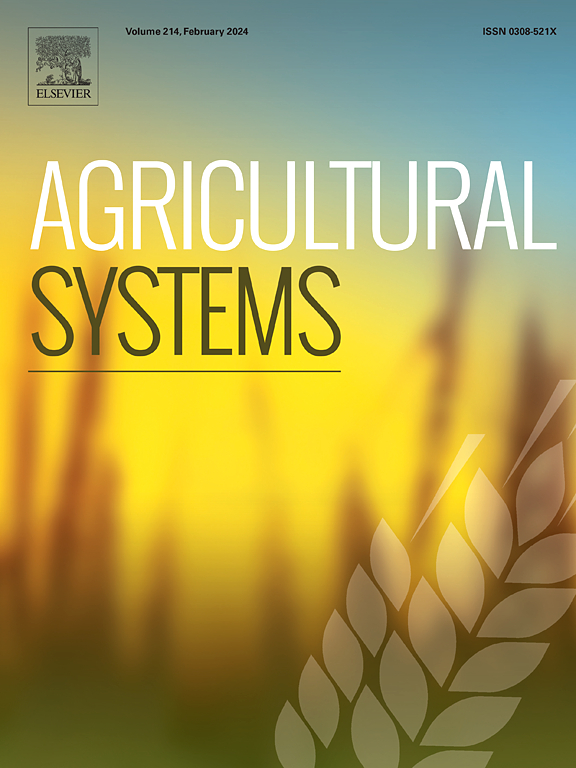水稻生长与品质积累的耦合建模有助于高效、优质和精准的水分管理
IF 6.1
1区 农林科学
Q1 AGRICULTURE, MULTIDISCIPLINARY
引用次数: 0
摘要
随着全球对优质稻米需求的不断增长,灌溉对优质产量至关重要。然而,传统做法往往表现出低用水效率和薄弱的控制。精确的每日灌溉改善了同化物的分布,提高了产量和粮食品质。本研究将AquaCrop模型与水稻品质模型相结合,模拟水稻的日常生长过程、品质积累以及灌溉、干物质生产和同化物分配之间的复杂动态关系。方法在此基础上,建立了一个动态灌溉模型,以优化关键目标,包括高产、少白垩、减少直链淀粉和提高蛋白质含量,同时生成每日灌溉情景,以协调产量、质量和水分效率。结果与结论产量、垩白度和直链淀粉之间呈正相关,而蛋白质水平的提高可减轻垩白度。在分蘖期的早期和中期确保基线供水,然后在随后的阶段进行亏缺灌溉,可以节约18.9%的水,减少36.6%的白垩。在拔节和孕穗期分配27.4%的水资源,节约水分13.1%,降低直链淀粉含量5.4%,稳定产量。在分蘖和抽穗阶段优先灌溉可减少8.6%的用水量,略微提高产量,并使蛋白质水平提高14.2%。此外,与丰水年相比,平水年在生育中期面临更强的温度胁迫,导致产量下降6.2%,但由于开花后氮吸收平衡,蛋白质增加12.8%;在干旱年份,有限的降水和生长后期的过热使白垩度增加23.3%,蛋白质含量减少5.4%。意义本研究建立的水稻高水分利用效率和优质灌溉决策模型将有助于制定精确的日灌溉计划。它适应不同的水文条件和决策者偏好,实现水稻增产、品质改良和保水的协同调控,为优质水稻生产提供决策支持。本文章由计算机程序翻译,如有差异,请以英文原文为准。

Coupled modeling of rice growth and quality accumulation facilitates efficient, high-quality and precision water management
CONTEXT
With rising global demand for high-quality rice, irrigation is vital for superior production. Yet, traditional practices often show low water-use efficiency and weak control. Precise daily irrigation improves assimilate distribution, enhancing both yield and grain quality.
OBJECTIVE
This study integrates the AquaCrop model with a rice quality model to simulate daily growth processes, quality accumulation, and the intricate dynamics linking irrigation, dry matter production, and assimilate distribution.
METHODS
Based on this, a dynamic irrigation model was developed to optimize key targets, including high yield, minimal chalkiness, reduced amylose, and enhanced protein content, while generating daily irrigation scenarios to harmonize yield, quality, and water efficiency.
RESULTS AND CONCLUSIONS
The results reveal a positive correlation between yield, chalkiness, and amylose, whereas improved protein levels mitigate chalkiness. Ensuring baseline water supply during early and mid-tillering stages, followed by deficit irrigation in subsequent phases, conserves 18.9 % of water and reduces chalkiness by 36.6 %. Allocating 27.4 % of water resources to the jointing and booting stages conserves 13.1 % of water, lowers amylose content by 5.4 %, and stabilizes yields. Prioritizing irrigation during tillering and heading stages reduces water use by 8.6 %, marginally increases yield, and elevates protein levels by 14.2 %. Additionally, compared to wet years, normal years face stronger temperature stress during mid-growth, causing a 6.2 % yield reduction but a 12.8 % protein increase due to balanced nitrogen uptake after flowering; in dry years, limited precipitation and excessive heat in late growth increase chalkiness by 23.3 % and reduce protein content by 5.4 %.
SIGNIFICANCE
The high water-use efficiency and quality irrigation decision model for rice developed in this study will facilitate the formulation of precise daily irrigation schedules. It adapts to varying hydrological conditions and decision-maker preferences, achieving synergistic regulation of rice yield increase, quality improvement, and water conservation, thereby providing decision support for high-quality rice production.
求助全文
通过发布文献求助,成功后即可免费获取论文全文。
去求助
来源期刊

Agricultural Systems
农林科学-农业综合
CiteScore
13.30
自引率
7.60%
发文量
174
审稿时长
30 days
期刊介绍:
Agricultural Systems is an international journal that deals with interactions - among the components of agricultural systems, among hierarchical levels of agricultural systems, between agricultural and other land use systems, and between agricultural systems and their natural, social and economic environments.
The scope includes the development and application of systems analysis methodologies in the following areas:
Systems approaches in the sustainable intensification of agriculture; pathways for sustainable intensification; crop-livestock integration; farm-level resource allocation; quantification of benefits and trade-offs at farm to landscape levels; integrative, participatory and dynamic modelling approaches for qualitative and quantitative assessments of agricultural systems and decision making;
The interactions between agricultural and non-agricultural landscapes; the multiple services of agricultural systems; food security and the environment;
Global change and adaptation science; transformational adaptations as driven by changes in climate, policy, values and attitudes influencing the design of farming systems;
Development and application of farming systems design tools and methods for impact, scenario and case study analysis; managing the complexities of dynamic agricultural systems; innovation systems and multi stakeholder arrangements that support or promote change and (or) inform policy decisions.
 求助内容:
求助内容: 应助结果提醒方式:
应助结果提醒方式:


